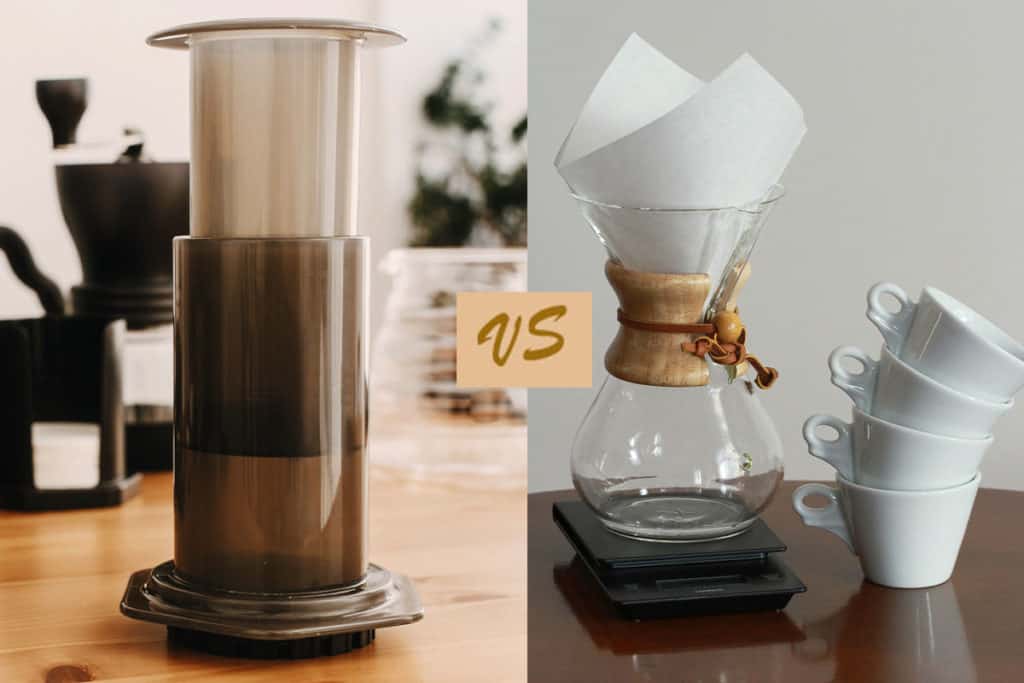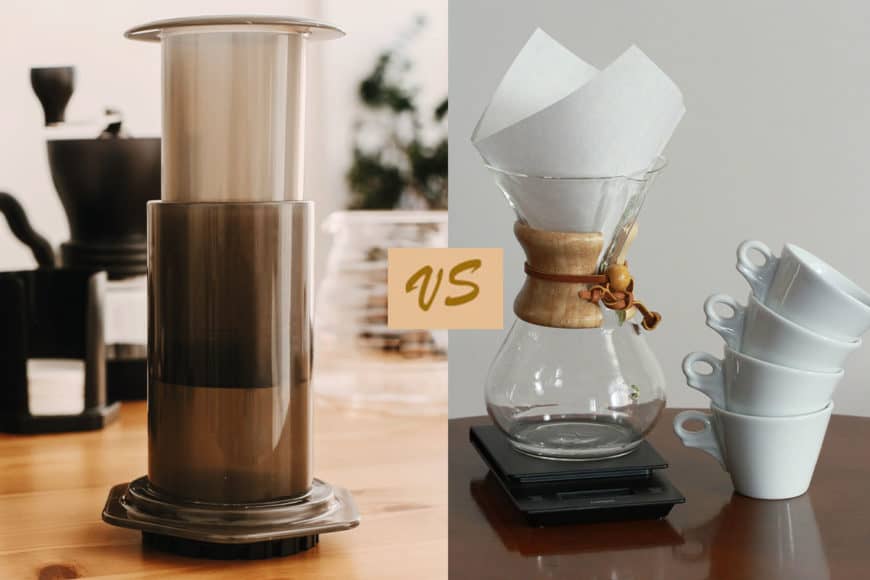
If you’re into specialty coffee, you’ve likely heard of the AeroPress and Chemex. Both are beloved by home baristas, but they brew coffee in distinct ways, delivering different flavors and experiences. In this guide, I’ll break down their differences, walk you through how to use each, and help you decide which one fits your coffee routine.
What Sets AeroPress and Chemex Apart?
The AeroPress and Chemex differ in design, brewing method, and practicality. Here’s a detailed look at five key areas: brew style, time, grind size, filters, and portability.
1. Brew Style
The AeroPress, invented in 2005, uses a hybrid of immersion and pressure brewing. You mix coffee grounds with hot water in a plastic chamber, stir, and press the mixture through a filter using a plunger. This creates a rich, full-bodied cup, often compared to espresso.
The Chemex, designed in 1941, is a pour-over brewer. Hot water flows through a bed of coffee grounds in a thick paper filter, dripping into a glass carafe below. The result is a clean, crisp coffee with bright, delicate flavors.
2. Brew Time
AeroPress is fast. Most recipes take 1–2 minutes, thanks to the pressure-driven extraction. It’s ideal for quick mornings or single servings.
Chemex brewing takes longer, typically 4–7 minutes, depending on the batch size (3–10 cups). The pour-over process requires multiple pours to control extraction, making it less rushed but more involved.
3. Grind Size
AeroPress works best with a medium-fine grind, similar to table salt. The finer grind maximizes surface area for quick extraction during the short brew time.
Chemex calls for a medium-coarse grind, like coarse sand. Larger particles slow water flow through the thick filter, ensuring even extraction over the longer brew time.
4. Filters
Chemex uses proprietary paper filters, 20% thicker than standard ones. These absorb coffee oils and trap sediment, producing a clean, sediment-free cup. They’re pricier and less widely available.
AeroPress offers paper or metal filters. Paper filters (often used in pairs) yield a cleaner cup by absorbing oils, while metal filters let oils and fine particles through for a fuller-bodied brew. Paper filters are affordable, with 300 per pack.
5. Portability
AeroPress shines for travel. Its lightweight, durable plastic design is nearly unbreakable, and the AeroPress Go model includes a mug/case for camping or trips.
Chemex, made of borosilicate glass, is fragile and bulky. Its elegant hourglass shape looks great on a kitchen counter but isn’t travel-friendly.
Brewing with AeroPress
Here’s how to brew a single cup (250ml) with an AeroPress:
- Prep: Heat 250ml water to 195–205°F. Place a paper filter in the filter cap and rinse with hot water to remove paper taste.
- Grind: Grind 17g coffee to a medium-fine consistency.
- Assemble: Attach the filter cap to the chamber. Place the AeroPress on a mug, inverted (plunger at the bottom).
- Brew: Add coffee to the chamber, pour in 250ml hot water, and stir for 10 seconds. Attach the filter cap, flip onto the mug, and press slowly for 20 seconds until you hear a hiss.
- Clean: Eject the used grounds and filter, rinse the AeroPress, and you’re done.
The result is a bold, rich coffee, perfect for espresso-style drinks or diluted for a standard cup.
Brewing with Chemex
For a three-cup Chemex (~450ml), follow these steps:
- Prep: Heat 500ml water to 195–205°F. Place a Chemex paper filter in the top, rinse with hot water, and discard the water.
- Grind: Grind 30g coffee to a medium-coarse consistency.
- Bloom: Add grounds to the filter. Pour 60ml water in a circular motion, let bloom for 30 seconds.
- Pour: Slowly pour 390ml more water in 30–50ml increments, aiming for a 4–5-minute total brew time.
- Serve: Remove the filter, pour, and enjoy.
This yields a smooth, clean coffee with bright notes, ideal for sharing.
Flavor and Versatility
AeroPress coffee is bold and full-bodied, with a slight grit if using metal filters. It’s versatile, handling espresso-style drinks, cold brew, or tea with adjusted recipes.
Chemex coffee is light and crisp, highlighting floral or citrus notes. Its thick filters remove oils, making it sediment-free. It’s also great for cold brew or reheating coffee on a stovetop.
Cleaning and Maintenance
AeroPress is a breeze to clean. Eject the grounds and filter, rinse, and it’s ready for the next brew. It’s even dishwasher-safe.
Chemex requires disposing of the filter and rinsing the carafe. Occasional soapy water cleans the glass, but the wooden collar needs care to avoid damage.
Comparison Table
| Feature | AeroPress | Chemex |
|---|---|---|
| Brew Style | Immersion/Pressure | Pour-Over |
| Brew Time | 1–2 minutes | 4–7 minutes |
| Grind Size | Medium-Fine | Medium-Coarse |
| Filters | Paper or Metal | Thick Paper |
| Portability | Highly Portable | Not Portable |
| Batch Size | 1 cup | 3–10 cups |
| Flavor | Bold, Full-Bodied | Clean, Crisp |
| Cleaning | Very Easy | Moderate |
| Price | ~$30–40 | ~$40–50 |
Which Should You Choose?
Pick the AeroPress if:
- You want a quick, bold coffee for one.
- You travel or camp often.
- You value versatility and easy cleanup.
Choose the Chemex if:
- You brew for multiple people.
- You prefer clean, bright coffee.
- You want an elegant kitchen centerpiece.
Both make excellent coffee, but your choice depends on your lifestyle and taste. Try experimenting with grind size and brew ratios to dial in your perfect cup.

